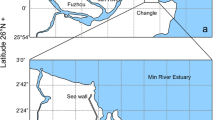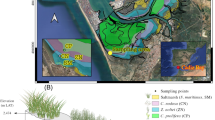Abstract
The microbial metabolism of organic matter (OM) in seagrass beds can create sulfidic conditions detrimental to seagrass growth; iron (Fe) potentially has ameliorating effects through titration of the sulfides and the precipitation of iron-sulfide minerals into the sediment. In this study, the biogeochemical effects of Fe availability and its interplay with sulfur and OM on sulfide toxicity, phosphorous (P) availability, seagrass growth and community structure were tested. The availability of Fe and OM was manipulated in a 2 × 2 factorial experiment arranged in a Latin square, with four replicates per treatment. The treatments included the addition of Fe, the addition of OM, the addition of both Fe and OM as well as no addition. The experiment was conducted in an oligotrophic, iron-deficient seagrass bed. Fe had an 84.5% retention efficiency in the sediments with the concentration of Fe increasing in the seagrass leaves over the course of the experiment. Porewater chemistry was significantly altered with a dramatic decrease in sulfide levels in Fe addition plots while sulfide levels increased in the OM addition treatments. Phosphorus increased in seagrass leaves collected in the Fe addition plots. Decreased sulfide stress was evidenced by heavier δ34S in leaves and rhizomes from plots to which Fe was added. The OM addition negatively affected seagrass growth but increased P availability; the reduced sulfide stress in Fe added plots resulted in elevated productivity. Fe availability may be an important determinant of the impact that OM has on seagrass vitality in carbonate sediments vegetated with seagrasses.





Similar content being viewed by others
References
Armitage AR, Frankovich TA, Heck KLJ, Fourqurean JW (2005) Experimental nutrient enrichment causes complex changes in seagrass, microalgae, and macroalgae community structure in Florida Bay. Estuaries 28:422–434
Azzoni R, Giordani G, Viaroli P (2005) Iron–sulfur–phosphorus interactions: implications for sediment buffering capacity in a Mediterranean eutrophic lagoon (Sacca di Goro, Italy). Hydrobiologia 550:131–148
Borum J, Pedersen O, Greve TM, Frankovich TA, Zieman JC, Fourqurean JW, Madden CJ (2005) The potential role of plant oxygen and sulphide dynamics in die-off events of the tropical seagrass, Thalassia testudinum. J Ecol 93:148–158
Calleja ML, Marba N, Duarte CM (2007) The relationship between seagrass (Posidonia oceanica) decline and sulfide porewater concentration in carbonate sediments. Estuar Coast Shelf Sci 73:583–588
Carlson PRJ, Forrest J (1982) Uptake of dissolved sulfide by Spartina alterniflora: evidence from natural sulfur isotope abundance ratios. Science 216:633–635
Carlson PR, Yarbro LA, Barber TR (1994) Relationship of sediment sulfide to mortality of Thalassia testudinum in Florida Bay. Bull Mar Sci 54:733–746
Chambers RM, Odum WE (1990) Porewater oxidation, dissolved phosphate and the iron curtain. Biogeochemistry 10:37–52
Chambers RM, Hollibaugh JT, Snively CS, Plant JN (2000) Iron, sulfur and carbon diagenesis in sediments of Tomales Bay, California. Estuaries 23:1–9
Chambers RM, Fourqurean JW, Macko SA, Hoppenot R (2001) Biogeochemical effects of iron availability on primary producers in a shallow marine carbonate environment. Limnol Oceanogr 46:1278–1286
Cline JD (1969) Spectrophotometric determination of hydrogen sulfide in natural waters. Limnol Oceanogr 14:454–458
de Kanel J, Morse JW (1978) The chemistry of orthophosphate uptake from seawater onto calcite and aragonite. Geochim Cosmochim Acta 42:1335–1340
Delgado O, Ruiz J, Pérez M, Romero J, Ballesteros E (1999) Effects of fish farming on seagrass (Posidonia oceanica) in a Mediterranean bay: seagrass decline after organic loading cessation. Oceanol Acta 22:109–117
Duarte CM (1990) Seagrass nutrient content. Mar Ecol Prog Ser 67:201–207
Duarte CM (1999) Seagrass ecology at the turn of the millennium: challenges for the new century. Aquat Bot 65:7–20
Duarte CM, Merino M, Gallegos M (1995) Evidence of iron deficiency in seagrasses growing above carbonate sediments. Limnol Oceanogr 40:1153–1158
Ferdie M, Fourqurean JW (2004) Responses of seagrass communities to fertilization along a gradient of relative availability of nitrogen and phosphorus in a carbonate environment. Limnol Oceanogr 49:2082–2094
Fourqurean JW, Robblee MB (1999) Florida Bay: a history of recent ecological changes. Estuaries 22:345–357
Fourqurean JW, Zieman JC, Powell GVN (1992a) Phosphorus limitation of primary production in Florida Bay: evidence from the C:N:P ratios of the dominant seagrass Thalassia testudinum. Limnol Oceanogr 37:162–171
Fourqurean JW, Zieman JC, Powell GVN (1992b) Relationships between porewater nutrients and seagrasses in a subtropical carbonate environment. Mar Biol 114:57–65
Frederiksen MS, Holmer M, Borum J, Kennedy H (2006) Temporal and spatial variation of sulfide invasion in eelgrass (Zostera marina) as reflected by its sulfur isotopic composition. Limnol Oceanogr 51:2308–2318
Halun Z, Terrados J, Borum J, Kamp-Nielsen L, Duarte CM, Fortes MD (2002) Experimental evaluation of the effects of siltation-derived changes in sediment conditions on the Philippine seagrass Cymodocea rotunda. J Exp Mar Biol Ecol 279:73–87
Heijs SK, van Gemerden H (2000) Microbial and environmentalvariables involved in the sulfide buffering capacity along a eutrophication gradient in a coastal lagoon (Bassin d’Arcachon, France). Hydrobiologia 437:121–131
Holmer M, Nielsen SL (1997) Sediment sulfur dynamics related to biomass-density patterns in Zostera marina (eelgrass) beds. Mar Ecol Prog Ser 146:163–171
Holmer M, Andersen FØ, Nielsen SL, Boschker HTS (2001) The importance of mineralization based on sulfate reduction for nutrient regeneration in tropical seagrass sediments. Aquat Bot 71:1–17
Holmer M, Duarte CM, Marbà N (2005) Iron additions reduce sulfate reduction rates and improve seagrass growth on organic-enriched carbonate sediments. Ecosystems 8:721–730
Holmer M, Pedersen O, Ikejima K (2006) Sulfur cycling and sulfide intrusion in mixed Southeast Asian tropical seagrass meadows. Bot Mar 49:91–102
Hupfer M, Dollan A (2003) Imobilisation of phosphorus by iron-coated roots of submerged macrophytes. Hydrobiologia 506:635–640
Jensen HS, McGlathery KJ, Marino R, Howarth RW (1998) Forms and availability of sediment phosphorus in carbonate sand of Bermuda seagrass beds. Limnol Oceanogr 43:799–810
Kamp-Nielsen L, Vermaat JE, Wesseling I, Borum J, Geertz-Hansen O (2001) Sediment properties along gradients of siltation in South-East Asia. Estuar Coast Shelf Sci 54:127–138
Kaplan IR, Rittenberg SC (1964) Microbial fractionation of sulphur isotopes. J Gen Microbiol 34:195–212
Kleikemper J, Schroth MH, Bernasconi SM, Brunner B, Zeyer J (2004) Sulfur isotope fractionation during growth of sulfate-reducing bacteria on various carbon sources. Geochim Cosmochim Acta 68:4891–4904
Koch MS, Erskine JM (2001) Sulfide as a phytotoxin to the tropical seagrass Thalassia testudinum: interactions with light, salinity and temperature. J Exp Mar Biol Ecol 266:81–95
Koch MS, Schopmeyer S, Kyhn-Hansen C, Madden CJ (2007) Synergistic effects of high temperature and sulfide on tropical seagrass. J Exp Mar Biol Ecol 341:91–101
Ku TCW, Walter LM, Coleman ML, Blake RE, Martini AM (1999) Coupling between sulfur recycling and syndepositional carbonate dissolution: evidence from oxygen and sulfur isotope composition of pore water sulfate, South Florida platform, USA. Geochim Cosmochim Acta 63:2529–2546
Landry MR, Constantinou J, Latasa M, Brown SL, Bidigare RR, Ondrusek ME (2000) Biological response to iron fertilization in the eastern equatorial pacific (IronEX II). III. Dynamics of phytoplankton growth on microzooplankton grazing. Mar Ecol Prog Ser 201:57–72
Lovley DR, Phillips EJP (1987) Competitive mechanisms for inhibition of sulfate reduction and methane production in the zone of ferric iron reduction in sediments. Appl Environ Microbiol 53:2636–2641
Marba M, Duarte CM, Holmer M, Martinez R, Basterretxea G, Orfila A, Jordi A, Tintoré J (2002) Effectiveness of protection of seagrass (Posidonia oceanica) populations in Cabrera National Park (Spain). Environ Conserv 29:509–518
Martin JH, Fitzwater SE (1988) Iron deficiency limits phytoplankton growth in the north-east Pacific subarctic. Nature 331:341–343
Miller GW, Punshnik JC, Welkie GW (1984) Iron chlorosis, a world wide problem, the relation to chlorophyll biosynthesis to iron. J Plant Nutr 7:1–22
Orth RJ, Carruthers TJB, Dennison WC, Duarte CM, Fourqurean JW, Heck KL, Hughes AR, Kendrick GA, Kenworthy WJ, Olyarnik S, Short FT, Waycott M, Williams SL (2006) A global crisis for seagrass ecosystems. Bioscience 56:987–996
Pergent G, Mendez S, Pergent-Martini C, Pasqualini V (1998) Preliminary data on the impact of fish farming facilities on Posidonia oceanica meadows in the Mediterranean. Oceanol Acta 22:95–107
Robblee MB, Barber TR, Carlson PR, Durako MJ, Fourqurean JW, Muehlstein LK, Porter D, Yarbro LA, Zieman RT, Zieman JC (1991) Mass mortality of the tropical seagrass Thalassia testudinum in Florida Bay (USA). Mar Ecol Prog Ser 71:297–299
Rosenfeld JK (1979) Interstitial water and sediment chemistry of two cores from Florida Bay. J Sediment Petrol 49:989–994
Short FT (1987) Effects of sediment nutrients on seagrasses: literature review and mesocosm experiment. Aquat Bot 27:41–57
Smolders AJP, Nijboer RC, Roelofs JGM (1995) Prevention of sulphide accumulation and phosphate mobilization by the addition of iron(II) chloride to a reduced sediment: an enclosure experiment. Freshw Biol 34:559–568
Stapel J, Hemminga MA, Bogert CG, Maas YEM (2001) Nitrogen (+15N) retention in small Thalassia hemprichii seagrass plots in an offshore meadow in South Sulawesi, Indonesia. Limnol Oceanogr 46:24–37
Terrados J, Duarte CM, Kamp-Nielsen L, Agawin NSR, Gacia E, Lacap D, Fortes MD, Borum J, Lubanski M, Greve T (1999) Are seagrass growth and survival constrained by the reducing conditions of the sediment? Aquat Bot 65:175–197
Thamdrup B, Fossing H, Jørgensen BB (1994) Manganese, iron, and sulfur cycling in a coastal marine sediment, Aarhus Bay, Denmark. Geochim Cosmochim Acta 58:5115–5129
Westrich JT, Berner RA (1984) The role of sedimentary organic matter in bacterial sulfate reduction: the G model tested. Limnol Oceanogr 29:236–249
Zieman JC, Fourqurean JW, Iverson RL (1989) Distribution, abundance and productivity of seagrasses and macroalgae in Florida Bay. Bull Mar Sci 44:292–311
Zieman JC, Fourqurean JW, Frankovich TA (1999) Seagrass dieoff in Florida Bay (USA): long-term trends in abundance and growth of turtle grass, Thalassia testudinum. Estuaries 22:460–470
Acknowledgments
We thank Bryan M. Dewsbury and Travis Thyberg for help during field work and collection of samples and Dr R.M. Price for performing the anion concentration analyses. Drs R.M. Chambers and D.L. Childers provided guidance on experimental design, analytical methods and data analyses and read and commented on early drafts of this paper. This material is based upon work supported by the National Science Foundation under the Florida Coastal Everglades Long Term Ecological Research program (Grant No. 9910514). This is contribution number 372 of the Southeast Environmental Research Center at FIU.
Author information
Authors and Affiliations
Corresponding author
Rights and permissions
About this article
Cite this article
Ruiz-Halpern, S., Macko, S.A. & Fourqurean, J.W. The effects of manipulation of sedimentary iron and organic matter on sediment biogeochemistry and seagrasses in a subtropical carbonate environment. Biogeochemistry 87, 113–126 (2008). https://doi.org/10.1007/s10533-007-9162-7
Received:
Accepted:
Published:
Issue Date:
DOI: https://doi.org/10.1007/s10533-007-9162-7




